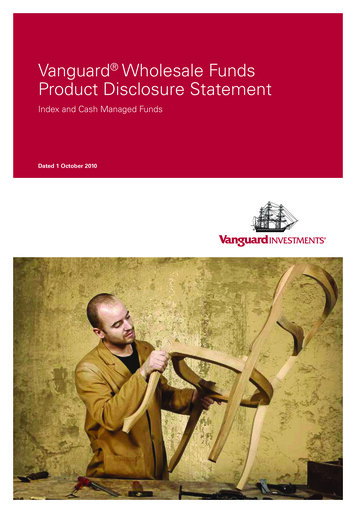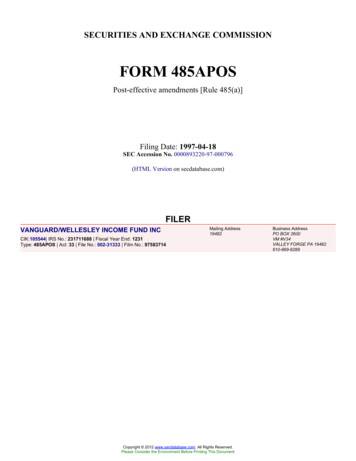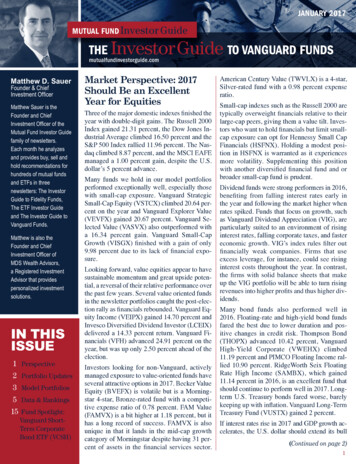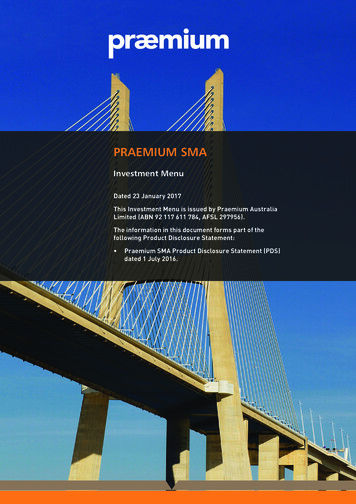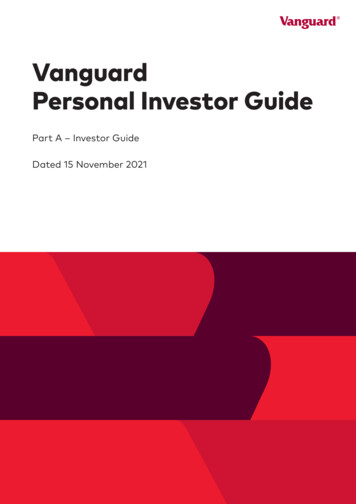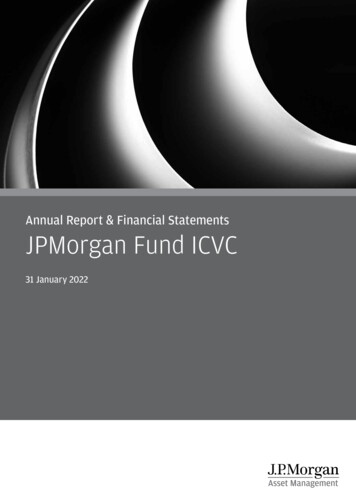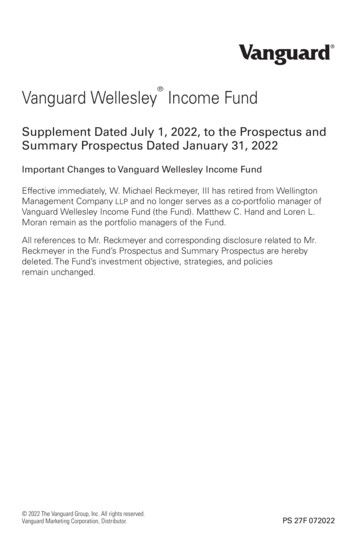
Transcription
Vanguard Wellesley Income FundSupplement Dated July 1, 2022, to the Prospectus andSummary Prospectus Dated January 31, 2022Important Changes to Vanguard Wellesley Income FundEffective immediately, W. Michael Reckmeyer, III has retired from WellingtonManagement Company LLP and no longer serves as a co-portfolio manager ofVanguard Wellesley Income Fund (the Fund). Matthew C. Hand and Loren L.Moran remain as the portfolio managers of the Fund.All references to Mr. Reckmeyer and corresponding disclosure related to Mr.Reckmeyer in the Fund’s Prospectus and Summary Prospectus are herebydeleted. The Fund’s investment objective, strategies, and policiesremain unchanged. 2022 The Vanguard Group, Inc. All rights reserved.Vanguard Marketing Corporation, Distributor.PS 27F 072022
Vanguard Wellesley Income FundProspectusJanuary 31, 2022Investor Shares & Admiral SharesVanguard Wellesley Income Fund Investor Shares (VWINX)Vanguard Wellesley Income Fund Admiral Shares (VWIAX)This prospectus contains financial data for the Fund through the fiscal year ended September 30, 2021.The Securities and Exchange Commission (SEC) has not approved or disapproved thesesecurities or passed upon the adequacy of this prospectus. Any representation to the contrary isa criminal offense.
ContentsFund SummaryMore on the Fund1 Investing With Vanguard297Purchasing Shares29The Fund and Vanguard19Converting Shares32Investment Advisor20Redeeming Shares34Dividends, Capital Gains, and Taxes22Exchanging Shares38Share Price25Frequent-Trading Limitations3827Other Rules You Should Know40Fund and Account Updates45Employer-Sponsored Plans46Financial HighlightsContacting Vanguard47Additional Information48Glossary of Investment Terms50
Fund SummaryInvestment ObjectiveThe Fund seeks to provide long-term growth of income and a high andsustainable level of current income, along with moderate long-termcapital appreciation.Fees and ExpensesThe following table describes the fees and expenses you may pay if you buy,hold, and sell Investor Shares or Admiral Shares of the Fund. You may pay otherfees, such as brokerage commissions and other fees to financial intermediaries,which are not reflected in the table and example below.Shareholder Fees(Fees paid directly from your investment)Sales Charge (Load) Imposed on PurchasesInvestor SharesNoneAdmiral SharesNonePurchase FeeSales Charge (Load) Imposed on Reinvested DividendsNoneNoneNoneNoneRedemption FeeAccount Service Fee Per Year(for certain fund account balances below 10,000)NoneNone 20 20Annual Fund Operating Expenses(Expenses that you pay each year as a percentage of the value of your investment)Investor SharesAdmiral SharesManagement Fees12b-1 Distribution FeeOther Expenses0.22%None0.01%0.16%None0.00%Total Annual Fund Operating Expenses0.23%0.16%1
ExamplesThe following examples are intended to help you compare the cost of investingin the Fund’s Investor Shares or Admiral Shares with the cost of investing inother mutual funds. They illustrate the hypothetical expenses that you wouldincur over various periods if you were to invest 10,000 in the Fund’s shares.These examples assume that the shares provide a return of 5% each year andthat total annual fund operating expenses remain as stated in the precedingtable. You would incur these hypothetical expenses whether or not you were toredeem your investment at the end of the given period. Although your actualcosts may be higher or lower, based on these assumptions your costs would be:Investor Shares1 Year 243 Years 745 Years 13010 Years 293Admiral Shares 16 52 90 205Portfolio TurnoverThe Fund pays transaction costs, such as commissions, when it buys and sellssecurities (or “turns over” its portfolio). A higher portfolio turnover rate mayindicate higher transaction costs and may result in more taxes when Fundshares are held in a taxable account. These costs, which are not reflected inannual fund operating expenses or in the previous expense examples, reducethe Fund’s performance. During the most recent fiscal year, the Fund’s portfolioturnover rate was 39% of the average value of its portfolio.Principal Investment StrategiesThe Fund invests approximately 60% to 65% of its assets in investment-gradefixed income securities that the advisor believes will generate a reasonable levelof current income, including corporate, U.S. Treasury, and government agencybonds, as well as mortgage-backed securities. The remaining 35% to 40% ofFund assets are invested in common stocks of companies that have a history ofabove-average dividends or expectations of increasing dividends.Principal RisksThe Fund is subject to the risks associated with the stock and bond markets, anyof which could cause an investor to lose money, and the level of risk may varybased on market conditions. However, because fixed income securities such asbonds usually are less volatile than stocks and because the Fund invests morethan half of its assets in fixed income securities, the Fund’s overall level of risk isexpected to be low to moderate. With approximately 60% to 65% of its assets allocated to bonds, the Fund isproportionately subject to the following bond risks: interest rate risk, which is the2
chance that bond prices overall will decline because of rising interest rates;income risk, which is the chance that the Fund’s income will decline because offalling interest rates; credit risk, which is the chance that a bond issuer will fail topay interest or principal in a timely manner or that negative perceptions of theissuer’s ability to make such payments will cause the price of that bond todecline; liquidity risk, which is the chance that the Fund may not be able to sell asecurity in a timely manner at a desired price; and call risk, which is the chancethat during periods of falling interest rates, issuers of callable bonds may call(redeem) securities with higher coupon rates or interest rates before theirmaturity dates. The Fund would then lose any price appreciation above thebond’s call price and would be forced to reinvest the unanticipated proceeds atlower interest rates, resulting in a decline in the Fund’s income. Suchredemptions and subsequent reinvestments would also increase the Fund’sportfolio turnover rate. For mortgage-backed securities, this risk is known asprepayment risk. With approximately 35% to 40% of its assets allocated to stocks, the Fund isproportionately subject to the following stock risks: stock market risk, which isthe chance that stock prices overall will decline; and investment style risk, whichis the chance that returns from mid- and large-capitalization dividend-payingvalue stocks will trail returns from the overall stock market. Mid- and large-capstocks each tend to go through cycles of doing better—or worse—than othersegments of the stock market or the stock market in general. These periodshave, in the past, lasted for as long as several years. Historically, mid-cap stockshave been more volatile in price than large-cap stocks. The stock prices ofmid-size companies tend to experience greater volatility because, among otherthings, these companies tend to be more sensitive to changingeconomic conditions. Manager risk, which is the chance that poor security selection will cause theFund to underperform relevant benchmarks or other funds with a similarinvestment objective.An investment in the Fund is not a deposit of a bank and is not insured orguaranteed by the Federal Deposit Insurance Corporation or any othergovernment agency.3
Annual Total ReturnsThe following bar chart and table are intended to help you understand the risksof investing in the Fund. The bar chart shows how the performance of the Fund’sInvestor Shares has varied from one calendar year to another over the periodsshown. The table shows how the average annual total returns of the shareclasses presented compare with those of a composite bond/stock index andother relevant market indexes, which have investment characteristics similar tothose of the Fund. The Wellesley Income Composite Index is weighted 65% inthe Bloomberg U.S. Credit A or Better Bond Index and 35% in the FTSE HighDividend Yield Index. Keep in mind that the Fund’s past performance (before andafter taxes) does not indicate how the Fund will perform in the future. Updatedperformance information is available on our website atvanguard.com/performance or by calling Vanguard toll-free at 800-662-7447.Annual Total Returns — Vanguard Wellesley Income Fund Investor 0.201.28–2.57During the periods shown in the bar chart, the highest and lowest returns for acalendar quarter were:HighestLowest4Total Return8.44%-7.42%QuarterJune 30, 2020March 31, 2020
Average Annual Total Returns for Periods Ended December 31, 20211 Year5 Years10 YearsVanguard Wellesley Income Fund Investor SharesReturn Before TaxesReturn After Taxes on Distributions8.50%6.588.02%6.347.65%6.03Return After Taxes on Distributions and Sale of Fund SharesVanguard Wellesley Income Fund Admiral Shares5.675.765.57Return Before TaxesWellesley Income Composite Index(reflects no deduction for fees, expenses, or taxes)Bloomberg U.S. Aggregate Bond Index(reflects no deduction for fees, expenses, or ow Jones U.S. Total Stock Market Float Adjusted Index(reflects no deduction for fees, expenses, or taxes)25.6617.9216.24Actual after-tax returns depend on your tax situation and may differ from thoseshown in the preceding table. When after-tax returns are calculated, it isassumed that the shareholder was in the highest individual federal marginalincome tax bracket at the time of each distribution of income or capital gains orupon redemption. State and local income taxes are not reflected in thecalculations. Please note that after-tax returns are shown only for the InvestorShares and may differ for each share class. After-tax returns are not relevant for ashareholder who holds fund shares in a tax-deferred account, such as anindividual retirement account or a 401(k) plan. Also, figures captioned ReturnAfter Taxes on Distributions and Sale of Fund Shares may be higher than otherfigures for the same period if a capital loss occurs upon redemption and resultsin an assumed tax deduction for the shareholder.Investment AdvisorWellington Management Company LLP (Wellington Management)Portfolio ManagersMatthew C. Hand, CFA, Managing Director and Equity Portfolio Manager ofWellington Management. He has co-managed the equity portion of the Fundsince October 2021.Loren L. Moran, CFA, Senior Managing Director and Fixed Income PortfolioManager of Wellington Management. She has managed the bond portion of theFund since 2017.5
W. Michael Reckmeyer, III, CFA, Senior Managing Director and Equity PortfolioManager of Wellington Management. He has managed the equity portion of theFund since 2007 (co-managed since October 2021).Purchase and Sale of Fund SharesYou may purchase or redeem shares online through our website (vanguard.com),by mail (The Vanguard Group, P.O. Box 982901, El Paso, TX 79998-2901), or bytelephone (800-662-2739). The minimum investment amount required to openand maintain a Fund account for Investor Shares or Admiral Shares is 3,000 or 50,000, respectively. The minimum investment amount required to add to anexisting Fund account is generally 1. Financial intermediaries, institutionalclients, and Vanguard-advised clients should contact Vanguard for information onspecial eligibility rules that may apply to them regarding Admiral Shares. If youare investing through an intermediary, please contact that firm directly for moreinformation regarding your eligibility. If you are investing through anemployer-sponsored retirement or savings plan, your plan administrator or yourbenefits office can provide you with detailed information on how you can investthrough your plan.Tax InformationThe Fund’s distributions may be taxable as ordinary income or capital gain. If youare investing through a tax-advantaged account, such as an IRA or anemployer-sponsored retirement or savings plan, special tax rules apply.Payments to Financial IntermediariesThe Fund and its investment advisor do not pay financial intermediaries for salesof Fund shares.6
More on the FundThis prospectus describes the principal risks you would face as a Fundshareholder. It is important to keep in mind one of the main principles ofinvesting: generally, the higher the risk of losing money, the higher the potentialreward. The reverse, also, is generally true: the lower the risk, the lower thepotential reward. As you consider an investment in any mutual fund, you shouldtake into account your personal tolerance for fluctuations in the securitiesmarkets. Look for thissymbol throughout the prospectus. It is used tomark detailed information about the more significant risks that you wouldconfront as a Fund shareholder. To highlight terms and concepts important tomutual fund investors, we have provided Plain Talk explanations along the way.Reading the prospectus will help you decide whether the Fund is the rightinvestment for you. We suggest that you keep this prospectus forfuture reference.Share Class OverviewThe Fund offers two separate classes of shares: Investor Shares andAdmiral Shares.Both share classes offered by the Fund have the same investment objective,strategies, and policies. However, different share classes have differentexpenses; as a result, their investment returns will differ.Plain Talk About Fund ExpensesAll mutual funds have operating expenses. These expenses, which arededucted from a fund’s gross income, are expressed as a percentage of thenet assets of the fund. Assuming that operating expenses remain as statedin the Fees and Expenses section, Vanguard Wellesley Income Fund’sexpense ratios would be as follows: for Investor Shares, 0.23%, or 2.30 per 1,000 of average net assets; for Admiral Shares, 0.16%, or 1.60 per 1,000 of average net assets. The average expense ratio for mixed-assettarget allocation conservative funds in 2020 was 0.69%, or 6.90 per 1,000of average net assets (derived from data provided by Lipper, a ThomsonReuters Company, which reports on the mutual fund industry).7
Plain Talk About Costs of InvestingCosts are an important consideration in choosing a mutual fund. That isbecause you, as a shareholder, pay a proportionate share of the costs ofoperating a fund and any transaction costs incurred when the fund buys orsells securities. These costs can erode a substantial portion of the grossincome or the capital appreciation a fund achieves. Even seemingly smalldifferences in expenses can, over time, have a dramatic effect on afund’s performance.The following sections explain the principal investment strategies and policiesthat the Fund uses in pursuit of its investment objective. The Fund’s board oftrustees, which oversees the Fund’s management, may change investmentstrategies or policies in the interest of shareholders without a shareholder vote,unless those strategies or policies are designated as fundamental. Note that theFund’s investment objective is not fundamental and may be changed without ashareholder vote.Plain Talk About Balanced FundsBalanced funds are generally investments that seek to provide somecombination of income and capital appreciation by investing in a mix ofstocks and bonds. Because prices of stocks and bonds can responddifferently to economic events and influences, a balanced fund shouldexperience less volatility than a fund investing exclusively in stocks, but mayexperience more volatility than a fund investing exclusively in bonds.Market ExposureBondsThe Fund invests approximately 60% to 65% of its assets in bonds.The Fund is subject to interest rate risk, which is the chance that bondprices overall will decline because of rising interest rates. Interest raterisk for the Fund is expected to be moderate because the averageduration of the Fund’s bond portfolio is intermediate-term and alsobecause the Fund’s equity portfolio consists primarily ofincome-generating stocks, which tend to be moderately sensitive tointerest rate changes.8
Although fixed income securities (commonly referred to as bonds) are oftenthought to be less risky than stocks, there have been periods when bond priceshave fallen significantly because of rising interest rates. For instance, prices oflong-term bonds fell by almost 48% between December 1976 andSeptember 1981.To illustrate the relationship between bond prices and interest rates, thefollowing table shows the effect of a 1% and a 2% change (both up and down) ininterest rates on the values of three noncallable bonds (i.e., bonds that cannotbe redeemed by the issuer) of different maturities, each with a face valueof 1,000.How Interest Rate Changes Affect the Value of a 1,000 Bond1After a 1%IncreaseAfter a 1%DecreaseAfter a 2%IncreaseAfter a 2%Decrease 977 1,024 954 1,049Intermediate-Term (10 years)9221,0868511,180Long-Term (20 years)8741,1507691,328Type of Bond (Maturity)Short-Term (2.5 years)1 Assuming a 4% coupon rate.These figures are for illustration only; you should not regard them as anindication of future performance of the bond market as a whole or the Fund inparticular. Also, because bonds make up only a portion of the Fund’s assets,changes in interest rates may not have as dramatic an effect on the Fund as theywould on a fund made up entirely of bonds.9
Plain Talk About Bonds and Interest RatesAs a rule, when interest rates rise, bond prices fall. The opposite is also true:Bond prices go up when interest rates fall. Why do bond prices and interestrates move in opposite directions? Let’s assume that you hold a bondoffering a 4% yield. A year later, interest rates are on the rise and bonds ofcomparable quality and maturity are offered with a 5% yield. Withhigher-yielding bonds available, you would have trouble selling your 4% bondfor the price you paid—you would probably have to lower your asking price.On the other hand, if interest rates were falling and 3% bonds were beingoffered, you should be able to sell your 4% bond for more than you paid.How mortgage-backed securities are different: In general, declining interestrates will not lift the prices of mortgage-backed securities—such as thoseguaranteed by the Government National Mortgage Association—as much asthe prices of comparable bonds. Why? Because when interest rates fall, thebond market tends to discount the prices of mortgage-backed securities forprepayment risk—the possibility that homeowners will refinance theirmortgages at lower rates and cause the bonds to be paid off prior tomaturity. In part to compensate for this prepayment possibility,mortgage-backed securities tend to offer higher yields than other bonds ofcomparable credit quality and maturity. In contrast, when interest rates rise,prepayments tend to slow down, subjecting mortgage-backed securities toextension risk—the possibility that homeowners will repay their mortgagesat slower rates. This will lengthen the duration or average life ofmortgage-backed securities held by a fund and delay the fund’s ability toreinvest proceeds at higher interest rates, making the fund more sensitive tochanges in interest rates.Changes in interest rates can affect bond income as well as bond prices.The Fund is subject to income risk, which is the chance that the Fund’sincome will decline because of falling interest rates. A fund holdingbonds will experience a decline in income when interest rates fallbecause the fund then must invest new cash flow and cash frommaturing bonds in lower-yielding bonds. Income risk for the Fund isexpected to be moderate because the average duration of the Fund’sbond portfolio is intermediate-term.10
Plain Talk About Bond MaturitiesA bond is issued with a specific maturity date—the date when the issuermust pay back the bond’s principal (face value). Bond maturities range fromless than 1 year to more than 30 years. Typically, the longer a bond’s maturity,the more price risk you, as a bond investor, will face as interest ratesrise—but also the higher the potential yield you could receive. Longer-termbonds are generally more suitable for investors willing to take a greater riskof price fluctuations to get higher and more stable interest income.Shorter-term bond investors should be willing to accept lower yields andgreater income variability in return for less fluctuation in the value of theirinvestment. The stated maturity of a bond may differ from the effectivematurity of a bond, which takes into consideration that an action such as acall or refunding may cause bonds to be repaid before their statedmaturity dates.Because bond and stock prices often move in different directions, the Fund’sstock holdings help to reduce—but not eliminate—some of the bond pricefluctuations caused by changes in interest rates. Likewise, stock market volatilitymay not have as dramatic an effect on the Fund as it would on a fund made upentirely of stocks.StocksThe remaining 35% to 40% of the Fund’s assets are invested in stocks.The Fund is subject to stock market risk, which is the chance that stockprices overall will decline. Stock markets tend to move in cycles, withperiods of rising prices and periods of falling prices.Stocks of publicly traded companies are often classified according to marketcapitalization, which is the market value of a company’s outstanding shares.These classifications typically include small-cap, mid-cap, and large-cap. It isimportant to understand that there are no “official” definitions of small-, mid-,and large-cap, even among Vanguard fund advisors, and that marketcapitalization ranges can change over time. The asset-weighted median marketcapitalization of the Fund’s stock holdings as of September 30, 2021, was 130 billion.Market disruptions can adversely affect local and global markets as well asnormal market conditions and operations. Any such disruptions could have anadverse impact on the value of the Fund’s investments and Fund performance.11
Security SelectionWellington Management, advisor to the Fund, invests approximately 60% to65% of the Fund’s assets in investment-grade bonds and approximately 35% to40% of the Fund’s assets in dividend-paying common stocks. Although the mixof stocks and bonds varies from time to time, depending on the advisor’s view ofeconomic and market conditions, generally bonds can be expected to representat least 60% of the Fund’s holdings.The Fund is managed according to traditional methods of active investmentmanagement. Securities are bought and sold based on the advisor’s judgmentsabout companies and their financial prospects and about bond issuers and thegeneral level of interest rates. The Fund’s advisor may, at times, select securitiesthat cause the Fund to focus in a particular market sector, which would subjectthe Fund to proportionately higher exposure to the risks of that sector.The Fund is subject to manager risk, which is the chance that poorsecurity selection will cause the Fund to underperform relevantbenchmarks or other funds with a similar investment objective.BondsWellington Management selects investment-grade bonds that it believes willgenerate a reasonable and sustainable level of current income. These mayinclude short-, intermediate-, and long-term corporate, U.S. Treasury, governmentagency, and asset-backed bonds, as well as mortgage-backed securities. Thebonds are bought and sold according to the advisor’s judgment about bondissuers and the general direction of interest rates, within the context of theeconomy in general. Although the Fund does not have specific maturityguidelines, the average duration of the Fund’s bond portfolio as ofSeptember 30, 2021, was 8 years.Plain Talk About Types of BondsBonds are issued (sold) by many sources: Corporations issue corporatebonds; the federal government issues U.S. Treasury bonds; agencies of thefederal government issue agency bonds; financial institutions issueasset-backed bonds; and mortgage holders issue “mortgage-backed”pass-through certificates. Each issuer is responsible for paying back thebond’s initial value as well as for making periodic interest payments. Manybonds issued by government agencies and entities are neither guaranteednor insured by the U.S. government.12
A breakdown of the Fund’s bond holdings (which amounted to approximately60% of the Fund’s net assets) as of September 30, 2021, follows:Type of BondIndustrialFinanceTreasury/AgencyPercentage of Fund’sBond vernment Mortgage-BackedAsset-Backed4.22.51.5Commercial Mortgage-Backed0.4Keep in mind that, because the bond makeup of the Fund can change daily, thislisting is only a “snapshot” at one point in time.The Fund is subject to credit risk, which is the chance that a bond issuerwill fail to pay interest or principal in a timely manner or that negativeperceptions of the issuer’s ability to make such payments will cause theprice of that bond to decline.The advisor purchases bonds that are of investment-grade quality—that is,bonds rated at least Baa3 by Moody‘s Investors Service, Inc., or BBB– byStandard & Poor‘s—or, if unrated, are determined to be of comparable quality bythe advisor.The U.S. government guarantees the timely payment of interest and principal forits U.S. Treasury bonds; some (but not all) agency bonds have the sameguarantee. The government does not, however, guarantee its bonds’ prices. Inother words, although U.S. Treasury and agency bonds may enjoy among thehighest credit ratings, their prices—like the prices of other bonds in theFund—will fluctuate with changes in interest rates.13
Plain Talk About Credit QualityA bond’s credit quality rating is an assessment of the issuer’s ability to payinterest on the bond and, ultimately, to repay the principal. The lower thecredit quality, the greater the perceived chance that the bond issuer willdefault, or fail to meet its payment obligations. All things being equal, thelower a bond’s credit quality, the higher its yield should be to compensateinvestors for assuming additional risk.Although falling interest rates tend to strengthen bond prices, they can causeanother problem for bond fund investors—bond calls.The Fund is subject to call risk, which is the chance that during periods offalling interest rates, issuers of callable bonds may call (redeem)securities with higher coupon rates or interest rates before their maturitydates. The Fund would then lose any price appreciation above the bond’scall price and would be forced to reinvest the unanticipated proceeds atlower interest rates, resulting in a decline in the Fund‘s income. Suchredemptions and subsequent reinvestments would also increase theFund’s portfolio turnover rate. For mortgage-backed securities, this risk isknown as prepayment risk. Call/prepayment risk is expected to be low tomoderate for the Fund because it invests only a limited portion of itsassets in callable bonds and mortgage-backed securities.Bond issuers take advantage of falling interest rates by calling corporate bonds.With mortgage-backed securities, it is the mortgage holder—such as the U.S.homeowner—who benefits from lower rates.The Fund is subject to liquidity risk, which is the chance that the Fundmay not be able to sell a security in a timely manner at a desired price.Corporate bonds are traded among dealers and brokers that connect buyers withsellers. Liquidity in the corporate bond market may be challenged depending onoverall economic conditions and credit tightening. There may be little trading inthe secondary market for particular bonds and other debt securities, which maymake them more difficult to value or sell.StocksThe Fund’s stocks are chosen primarily for their dividend-paying capabilities, butthey must also have the potential for moderate long-term capital appreciation.The advisor looks for stocks of companies that either offer significant dividendsnow or expect to increase their dividends in the future. This income orientation14
leads the Fund to invest in stocks with higher-than-market-average dividendyields. As a result, the Fund’s equity holdings are expected to have more of avalue orientation than a growth orientation.Plain Talk About Growth Funds and Value FundsGrowth investing and value investing are two styles employed by stock-fundmanagers. Growth funds generally invest in stocks of companies believed tohave above-average potential for growth in revenue, earnings, cash flow, orother similar criteria. These stocks typically have low dividend yields, if any,and above-average prices in relation to measures such as earnings and bookvalue. Value funds typically invest in stocks whose prices are below averagein relation to those measures; these stocks often have above-averagedividend yields. Value stocks also may remain undervalued by the market forlong periods of time. Growth and value stocks have historically producedsimilar long-term returns, though each category has periods when itoutperforms the other.The Fund is subject to investment style risk, which is the chance thatreturns from mid- and large-capitalization dividend-paying value stockswill trail returns from the overall stock market. Mid- and large-cap stockseach tend to go through cycles of doing better—or worse—than othersegments of the stock market or the stock market in general. Theseperiods have, in the past, lasted for as long as several years. Historically,mid-cap stocks have been more volatile in price than large-cap stocks.The stock prices of mid-size companies tend to experience greatervolatility because, among other things, these companies tend to be moresensitive to changing economic conditions.Other Investment Policies and RisksIn addition to investing in bonds and stocks, the Fund may make other kinds ofinvestments to achieve its investme
Vanguard Wellesley Income Fund Supplement Dated July 1, 2022, to the Prospectus and Summary Prospectus Dated January 31, 2022 Important Changes toVanguard Wellesley Income Fund Effective immediately, W. Michael Reckmeyer, III has retired from Wellington Management Company LLP and no longer serves as a co-portfolio manager of
